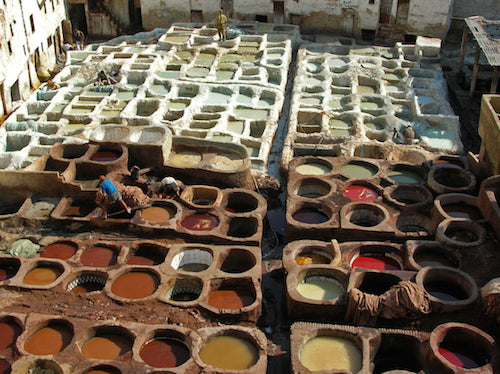We’re always looking for shortcuts, ways to speed up time. We eat instant foods from the supermarket and drive-thrus, exercise on machines that are built to shorten our workouts, and we multitask through our overscheduled days with the expectation that we can do it all at once. Some shortcuts are beneficial; many are not.
Shortcuts used in the process of leather tanning can be toxic. Today we’re going to explore the many reasons why you should seek out vegetable tanned leather over mass-produced chemical-laden leather.
What is chemical leather tanning?
Many things on the market today are touted as natural that simply aren't. Take most leather bags as an example. Sure, the leather that was used to construct your tote was a natural hide at some point, but that came long before it was treated with toxic substances and soaked in unnatural dyes. The caustic agents that are used to prepare and tan leather by major manufacturers can make all-natural leather very unnatural.
Tanning is the process of preserving leather so that it does not decay. In an effort to speed up the process, many factories use synthetic tanning agents and chemical treatments to color and safeguard rawhide. Not only are these chemicals toxic, they’re often poisonous to communities and workers. And that’s to say nothing of the people who buy and wear that leather.
Some of the chemicals used in the manufacturing of leather today include:
- Ammonia: Classified as dangerous for the environment.
- Aniline dyes: Toxic when inhaled or absorbed into the skin.
- Arsenic: A potent poison that can contaminate plants and water.
- Azo dyes: Synthetic coloring agents that have been banned in many countries.
- Chlorophenols: A respiratory tract, liver, eye and skin irritant.
- Chromium: A known cancer-causing agent.
- Formaldehyde: A known human carcinogen.
- Hexavalent chromium: A highly toxic known carcinogen.
- Hydrogen sulfide: Considered a broad-spectrum poison.
- Mercury: A toxic element that harms skin and lungs, and poisons the air.
- Sodium dichromate: An inorganic compound thought to cause cancer.
- Sulfuric acid: A corrosive mineral acid lung and tissue damage.
In total, some 250 chemicals can be used in combination when leather tanning is mass produced in a rush to make more and to cut costs.
Not only is chemical tanning hazardous to those who work in leather factories, but it’s also deadly for those who live nearby. Chemical leather tanning creates noxious fumes, pollutes water and air, and is destructive to the environment in every imaginable way.
What is vegetable tanning?
Vegetable tanning is an artisan tradition dating back thousands of years. This all-natural method of preserving leather uses plant compounds called tannins to season and protect raw hides and turn them into vibrant, rich pieces of leather. Natural tannins include things like tree bark, wood, leaves, fruits, roots and vegetables. The process of vegetable tanning is slow, sometimes taking several months to treat a single hide. The end result of this ethical tanning method is that you’re left with a pliable, strong leather that’s rich in natural color. And it’s all done without polluting the environment.
The vegetable tanned advantage
The benefits of vegetable tanning over chemical tanning are numerous.
- It’s environmentally friendly
- Each piece of leather is unique.
- The colors of leather are warmer and richer.
- Everything is done by hand and with great care.
- Only natural ingredients are used.
- No ill health effects.
- Completely biodegradable.
- Leathers get better looking with time and age.
- Skilled craftsmen hand work leather, not machines that can’t see mistakes.
- Smells sweet, not chemical-like.
- Scratches in leather can be easily buffed out
When you find something that works, you generally stick with it. If you appreciate the fine craftsmanship of German automobiles you’re probably not going to invest in a Ford in the future. The same is true for most things. The ancient art of vegetable tanning leather is far superior to shortcuts used by manufacturers today. Given the choice, doesn’t all-natural vegetable-tanned leather make sense?

